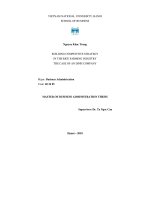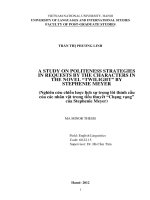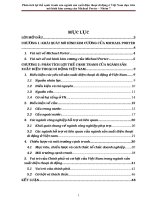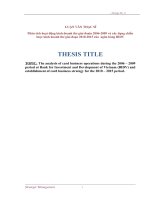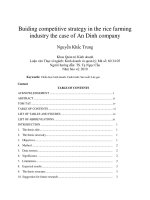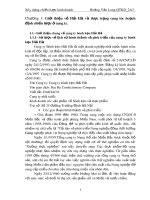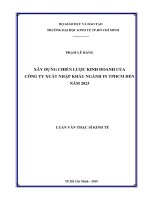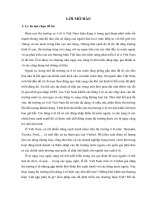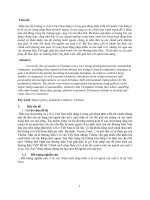buiding competitive strategy in the rice farming industry the case of an dinh company xây dựng chiến lược cạnh tranh trong ngành sản xuất lúa gạo
Bạn đang xem bản rút gọn của tài liệu. Xem và tải ngay bản đầy đủ của tài liệu tại đây (5.89 MB, 92 trang )
VIETNAM NATIONAL UNIVERSITY, HANOI
SCHOOL OF BUSINESS
Nguyen Khac Trung
BUILDING COMPETITIVE STRATEGY
IN THE RICE FARMING INDUSTRY
THE CASE OF AN DINH COMPANY
Major: Business Administration
Code: 60 34 05
MASTER OF BUSINESS ADMINISTRATION THESIS
Supervisor: Dr. Ta Ngoc Cau
Hanoi – 2010
- vi -
TABLE OF CONTENTS
ACKNOWLEDGEMENT……………………………………………………… i
ABSTRACT…………………………………………………………………… ii
TÓM TẮT………………………………………………………………………. iv
TABLE OF CONTENTS……………………………………………………… vi
LIST OF TABLES AND FIGURES …. ix
LIST OF ABRREVEATIONS…………………………………………………… xi
INTRODUCTION……………………………………………………………… 1
1. The thesis title.………………………………………………………………. 1
2. The thesis necessity…… ………………………………………………… 1
3. Objectives………………………………………………………………… 1
4. Method……………………………………………………………………… 2
5. Data sources………………………………………………………………… 2
6. Significance…………………………………………………………………. 2
7. Limitations………………………………………………………………… 3
8. Expected results…………………………………………………………… 3
9. The thesis structure………………………………………………………… 3
10. Suggestion for future research………………………………………………. 3
CHAPTER 1: LITERATURE REVIEW ………………………………………. 4
1.1 Competitive strategy………………………………………………………… 4
1.1.1 Strategy and business strategy…………………………………………… 4
1.1.2 Competitive strategy………………………………………………………. 5
1.2 Strategic management……………………………………………………… 10
1.2.1 Vision and mission………………………………………………………… 11
- vii -
1.2.2 Strategy formulation and selection…………………………………………. 12
1.2.3 Strategy implementation……………………………………………………. 27
1.2.4 Strategy evaluation…………………………………………………………. 28
CHAPTER 2 : RICE FARMING INDUSTRY IN VIET NAM…………………. 30
2.1 An overview of rice farming ………………………………………………. 30
2.2 The developing of rice farming industry in Viet Nam………………………. 32
2.3 Factors effecting rice farming ……………………………………………… 35
CHAPTER 3 : BUILDING COMPETITIVE STRATEGY……………………… 39
3.1 Company profile……………………………………………………………… 39
3.2 Strategy formulation …………………………………………………………. 41
3.2.1 External environment analysis……………………………………………… 41
3.2.2 Industry environment analysis……………………………………………… 51
3.2.3 Internal environment analysis……………………………………………… 56
3.2.4 SWOT analysis …………………………………………………………… 63
3.2.5 Strategy formulation and selection ………………………………………… 64
3.2.5.1 Production expanding ……………………………………………………. 65
3.2.5.2 Japanese rice farming and Vietnamese high quality rice processing ……. 65
3.2.5.3 Rice seed producing ……………………………………………………… 65
3.2.5.4 Marketing enhancing …………………………………………………… 65
3.3 Implementing the competitive strategy ………………………………………. 66
3.3.1 Objectives ………………………………………………………………… 66
3.3.2 Solutions …………………………………………………………………… 67
- viii -
3.3.3 Action plan ………………………………………………………………. 68
3.3.4 Recommendations to AnDinh Company ………………………………… 70
3.3.5 Recommendation to the government …………………………………… 71
CONCLUSION ………………………………………………………………… 72
REFERENCES ………………………………………………………………… 73
APENDDICES ………………………………………………………………… 75
- ix -
LIST OF TABLES AND FIGURES
Table 1.1 Example of possible factors in a PEST analysis
Table 1.2 Industry’s entry and exit barriers
Table 1.3 Bargaining powers of suppliers and buyers
Table 1.4 The completed SWOT profile
Table 1.5 Appropriate strategies selection (GREAT model)
Table 2.1 The world rice production
Table 2.2 The world rice consumption and stocks
Table 3.1 Vietnam quarterly GDP growth
Table 3.2 An Dinh external environment EFE matrix
Table 3.3 External environment analysis conclusion
Table 3.4 Industry analysis conclusion
Table 3.5 An Dinh internal environment IFE matrix
Table 3.6 Internal environment analysis conclusion
Table 3.7 Competitive strength assessment
Table 3.8 Sustainable competitive advantage
Table 3.9 AD Company’s SWOT profile
Table 3.10 AD Company’s appropriate strategies selection (GREAT model)
Table 3.11 AD Company’s action plan
Figure 1.1 Porter’s Generic Strategies
Figure 1.2 The strategic management process
Figure 1.3 Five Forces Model
Figure 1.4 The value chain
- x -
Figure 1.5 Strategic analysis processes
Figure 1.6 SWOT Matrixes
Figure 2.1 Vietnam rice farming areas
Figure 2.2 Vietnam rice productions
Figure 2.3 Rice volumes for consume and export (thousand tons)
Figure 2.4 Vietnam export value by rice and commodity group (2009)
Figure 2.5 Vietnam agro-forestry and rice export value (US $billion)
Figure 3.1: Corruption Perceptions Index 2009
Figure 3.2 Vietnam GDP per capita growth
Figure 3.3 VND/USD exchange rate (2008-2010)
Figure 3.4 Vietnam population pyramid (2009)
Figure 3.5 Impacts of sea level rise (1m scenario)
Figure 3.6 Value chain model in rice farming industry
Figure 3.7 AD Company Revenue and Net profit
Figure 3.8 AD Company’s organizational structure
Figure 3.9 AD Company’s SWOT matrix
Figure 3.10 AD Company’s strategies implementation process
- xi -
LIST OF ABRREVEATIONS
R&D: Research and Development
PEST: Politics, Economics, Social, Technology
SWOT: Strengths, Weaknesses, Opportunities, Threats
EFE: External Factor Evaluation
IFE: Internal Factor Evaluation
GREAT: Gain, Risk, Expense, Achievable, Time
USDA: United State Department of Agriculture
GSO: General Statistics Office
No: Number
WTO: World Trade Organization
IMF: International Monetary Fund
UK: United Kingdom
GDP: Gross Domestic Product
VCCI: Viet Nam Chamber of Commerce and Industry
CPI: Consumer Price Index
USA: United State of America
AD: An Dinh
FAO: Food and Agriculture Organization
US $: United State Dollar.
- 1 -
INTRODUCTION
1. The thesis title
Building competitive strategy in the rice farming industry - The case of An Dinh
Company.
2. The thesis necessity
The event of Viet Nam joining WTO in 2007 has created a range of development
opportunities and challenges to investors in rice farming in Vietnam. Vietnam is
known as one of world’s richest agricultural regions and is the second-largest
(after Thailand) exporter worldwide and the world's seventh-largest consumer of
rice.Vietnam government has made effort in order to develop high quality and
value-added rice production and export. An Dinh - a rice farming and trading
company- has been case-studied and researched that its rice production is limited
in capability resulted in an irrelative market share. A higher position in the market
requires a competitive strategy implementation by intensively investing in
expansion and enhancing marketing activities.
This thesis, in above actual fact, is to build an appropriate competitive strategy for
An Dinh Company’s development. It has also added the value to the strategy
formulation by giving recommendations and proposing an action plan, which can
be applied in implementing strategies.
3. Objectives
The objectives of this thesis are to (a) review the theory of building competitive
strategies, (b) provide an overview of rice farming industry in Vietnam, (c) present
An Dinh Company and analyze its business environment, and (d) build an
appropriate competitive strategy for company’s further development. The study
also gives a number of insights into company’s current strength and weakness, and
identifying an action plan for production expansion.
- 2 -
4. Methodology
This thesis applies the case study to build competitive strategy for An Dinh
Company. The research has been prepared mainly through on desk study reviews
of available literature and data through three basic steps:
The first step is to review theories of competitive strategy and strategic
management. The study focuses on the literature view of existing approaches to
competitive strategy formulation, and identifies a common process to build
competitive strategies.
The second step based on the research of rice farming industry in Vietnam in
terms of factors and influence on the business success.
Last but not less, the case study of An Dinh Company is analyzed inclusive of
interview with the managers of company who are responsible for strategic
management planning. This is to contribute competitive strategy and provide
recommendations on strategy implementation.
5. Data sources
The theoretical review and collection of secondary data display from research of
books, reports, newspapers and internet sources. The primary data was collected
through interviews with An Dinh Company’s managers and key employees.
6. Significance
By reviewing the theory of competitive strategy and strategic management and
understanding the impacts of business environment, the thesis benefits An Dinh
Company in implementing appropriate competitive strategies. This theoretical
approach could be applied in cases of other companies in rice farming industry.
- 3 -
7. Limitations
The study would be limited due to a small number of competitors in the local
market are considered. Moreover, those competitors could not be analyzed with
detail information and data, which may not entirely reflect the industry’s
competitive environment.
8. Expected results
The result of this thesis is to build appropriate competitive strategies for further
development of An Dinh Company. The methodology is expected to be applied
effectively in the case study of other companies in rice farming industry.
9. The thesis structure
Beginning with the introduction part, the thesis concludes three chapters and the
conclusion part.
Chapter 1 provides a fundamental review of competitive strategy and strategic
management theory focusing on the competitive strategy formulation process.
Chapter 2 discusses rice farming status in Vietnam, highlighting its latest
achievement and key factors.
Chapter 3 presents An Dinh Company and analyzes its environment to identify
external opportunities and threats as well as internal strength and weakness that
influence on building company’s competitive strategy. Action shall be
recommended for strategic management implementation.
10. Suggestion for future research
A rapid change of factors like technological advances, climate, and customer’s
lifestyle creates both opportunities and challenges to the rice farming industry and
An Dinh Company. Therefore, a deeper research undertaken could create more
benefit to larger size companies.
- 4 -
CHAPTER 1
LITERATURE REVIEW
The importance of competitive strategy and strategic management for
organizational success is now recognized in both the literature and practice.
Strategy and strategic management are necessary for an organization to achieve its
objectives, enhance competitive advantages and improve its value.
Today highly competitive business world pressures on managers and employees
across functional areas at all organizational levels to be taken on strategic
responsibilities. It is essential that they understand both strategic management
concept and process.
This chapter provides the basic understanding of competitive strategy and strategic
management. It focuses on strategy formulation as a part of the strategic
management.
1.1. Competitive strategy
1.1.1 Strategy and business strategy
Strategy is a plan designed to achieve a particular long-term goal.
1
There is very little agreement about the meaning of strategy in the world of
business. Although strategists and practitioners understand strategy in different
ways and in various contexts, there are some most common concepts:
2
Strategy is perspective, which is vision and direction
Strategy is position, it reflects decisions to offer particular products and
services in particular markets
Strategy is a plan, a “how”, a means of getting from here to there
1
Oxpord English Dictionary
2
Henry Mintzberg (1994), “The Rise and Fall of Strategic Planning”
- 5 -
Strategy is a pattern in actions over time
Strategy is the art of the general.
3
Strategy refers to how an objective will be
achieved, thereby; it is broad, long term and far reaching. Strategy is more
concerned with deploying the resources whereas tactics is concerned with
employing them. In business, as in military, strategy bridges the gap between
policy and tactics. Together, strategy and tactics bridge the gap between ends and
means.
Business strategy is a plan for how a firm will compete, what its goals should be
and what policies will be need to achieve goals.
4
The business strategy is a combination of the investment decision and the
development of a sustainable competitive advantage. The investment decision of a
business strategy covers the product and market, its investment intensity and the
resource allocation. The development of a sustainable competitive advantages
based on advantages of a business such as assets, technology, human resource,
management.
1.1.2 Competitive strategy
Since publication, Michael E. Porter’s “Competitive Strategy” has introduced the
theory and practice of business strategy throughout the world.
He defines competitive strategy as:
Competitive strategy is the search for a favorable competitive position in an
industry, the fundamental arena in which competition occurs. Competitive
strategy aims to establish a profitable and sustainable position against the
forces that determine industry competition.
5
3
Fred Nickols (2000), “Strategy: Definitions and Meaning”, www.nickols.us
4
Oxford English Dictionary
5
Michael Porter (1985), “Competitive Advantage: Creating and Sustaining Superior Performance”
- 6 -
Competitive strategy is a combination of the ends (goals) for which the firm is
striving and the means (policies) by which it is seeking to get there.
6
After analyzing the complexity of industry competition, Michael Porter presents
the three generic strategies: cost leadership, differentiation and focus, which can
be implemented at the business unit level to create a competitive advantage and
defend against the effects of the five factors. The four basic alternative
competitive strategies are Cost Leadership, Differentiation, Cost Focus and
Differentiation Focus.
Figure 1.1 Porter’s Generic Strategies
Source: Michael Porter, 1980
1.1.2.1 Cost Leadership:
Cost leadership strategy: Producing the same product or service at a lower cost
than competitors. Creating a more efficient production or service delivery process
than that of competitors allows the company to sell at a lower price and be
profitable.
Companies using the cost leadership strategy often have some characters:
- Good ability to approach the capital for investing in production. This is the
barrier for another company.
6
Michael Porter (1998), “Competitive strategy”
- 7 -
- High technical production capacity
- Good and large distribution channel.
Toyota is an example of implementing cost leadership strategy.
Toyota is a famous motor corporation in Japan, which applies successfully, cost
leadership strategy. The production system is really effectiveness with the lean
production and TPS. Both Lean and TPS can be seen as a loosely connected set of
potentially competing principles whose goal is cost reduction by the elimination of
waste. These principles include of: Pull processing, perfect first-time quality,
waste minimization, continuous improvement, flexibility, building and maintaining
a long-term relationship with suppliers, smart automation, load leveling and
production flow and visual control. This production system create a high technical
production capacity and effectiveness that supply to customer a good product with
low price compare to another product and make the Toyota achieve the position of
largest motor production in the world now. Moreover, the strength financial
support from Japanese government and the large distribution network over the
world also contribute to the achievement of Toyota today.
1.1.2.2 Differentiation:
Differentiation strategy: Same products or services are produced at a higher
quality than competitors’ are.
Companies using the differentiation strategy often have some characters:
- Good team in research and development (R&D)
- Good sales team: Ability to communicate information of product to
customer
- Reputation and ability to innovative
- 8 -
Amway is an example of implementing differentiation strategy.
Amway is a corporation based in United State established in 1959, now company
operates in more than 80 countries and territories over the world, getting $8.2
billion turnover in 2008. Amway focuses on producing high quality product and
differentiation strategy. Amway has strong research and development system with
65 research and development laboratories worldwide staffed by more than 500
scientists, engineers and technical professionals. Amway research and
development have been awarded more than 500 patents and have had more than
400 papers published in top industry journals. Amway is a leader in the U.S.
Direct Selling Association, the World Federation of Direct Selling Associations,
the National Association of Manufacturers, and the U.S. Chamber of Commerce,
Amway was ranked #43 on the Forbes Magazine 2007 list of “America’s Largest
Private Companies.” Over the past 50 years, Amway has been recognized for
manufacturing excellence, environmental concern, and commitment to safety and
health.
Amway has more than 3 million Amway Business Owners and 13,000 people work
in Amway and its subsidiaries. Amway is a company that believes every person
can make a difference. They live this philosophy every day. They empower their
employees to reach goals, fulfill ambitions, and contribute to the communities
where they operate. People who work with Amway stay at Amway. Most of
employees have been in Amway for more than 10 years, with many working here
for decades.
Amway is successful company applying differentiation strategy.
1.1.2.3 Focus:
Focus strategy: Strategy focusing exclusively on a narrow segment of the market.
- 9 -
A focus (or niche) strategy is most suitable for small firms but can be used by any
company, especially those can afford neither a wide scope cost leadership nor a
wide scope differentiation strategy. Companies could use a cost focus or a
differentiation focus. With a cost focus, a firm aims at being the lowest cost
producer in that segment. With a differentiation focus, a firm creates competitive
advantage through differentiation within the segment.
The appropriate generic strategy will help the firm to leverage its strengths and
defend against the five forces’ effects. Otherwise, Michael Porter specifically
emphasized that only one of the generic strategy alternatives should be pursued for
a given product, rather than implementing a combination of these strategies.
Therefore, organizations should take their competencies and strengths into
consideration to choose the most suitable generic strategy.
As Michael Porter opinion, enterprises can be successful in using combination of
these strategies when they establish separated company following one strategy.
Rayonier’s is one example of company implementing focus strategy
Rayonier's medium-density fiberboard plant is largest panel plant in New
Zealand. Its capacity can produce 170,000 cubic meters of annually.
This company is using focus strategy for its product. This strategy is focusing
particular buyers who bought MDF for house construction and large furniture
making. It has only produced MDF panels with thickness from 2cm to 5cm.
Rayonier segmented its product line even they can produce other kinds of
thickness. The reason is that they found the demand of house construction and
large furniture making in this country and by focusing those kind of products they
can get more profits.
The strategy is focusing on a particular buyer group, segment of the product line,
or geographic market. As differentiation, focus may take many forms. Although the
low cost and differentiation strategies are aimed at achieving their objectives
industry wide, the entire focus strategy is built around serving a particular target
- 10 -
very well, and each functional policy is developed with this in mind. The strategy
rests on the foundation that the firm is thus able to serve its narrow strategic
target more effectively or efficiently than competitors who are competing more
broadly. As a result, the firm achieves either differentiation from better meeting
the need of the particular target, or lower costs in serving this target, or both.
Even though the focus strategy does not achieve low cost or differentiation from
the perspective of the market as a whole, it does achieve one or both of these
positions with its narrow market target.
1.2. Strategic management
Strategic management is the process by which top-management determines the
long-term direction and performance of the organization by ensuring that careful
formulation, effective implementation and continuous evaluation of the strategy
take place.
7
The strategic management, hence, is an objective, logical and
systematic approach for decision making in an organization.
7
Lloyd L. Byars, Leslie W. Rue, Shaker A. Zahra (1996), “Strategic management”
- 11 -
Figure 1.2 The strategic management process
1.2.1 Vision and Mission
Vision describes aspirations for the future without specifying the means to achieve
desired ends.
8
The most effective vision must be inspirational, which requires for
8
Alex Miller, Gregory G. Dess (1996), “Strategic management”
Vision
Mission
External
environment
analysis
• PEST
analysis
• Five – forces
analysis
Internal
environment
analysis
• Value
chain
SWOT
Analysis
Strategy
implementation
Strategy
formulation &
selection
Strategy evaluation
- 12 -
the best, the most or the greatest. A vision becomes more visible when it is
expressed in the form of a mission statement.
A company’s mission is its reason for being. The mission statement describes the
company’s business vision, including the unchanging values and purpose of the
firm and forward-looking visionary goals that guide the pursuit of future
opportunities.
1.2.2 Strategy formulation and selection
Strategy formulation includes identifying an organization’s external opportunities
and threats, analyzing internal strengths and weakness, generating alternatives
strategies, and choosing the most appropriate strategies to pursue.
1.2.2.1 External environment analysis
The external environment has two aspects: the macro-environment that affects all
firms and the microenvironment that affects only firms in a particular industry. A
PEST analysis is a technique for understanding the macro-environment in which a
firm operates. PEST analysis includes Political, Economic, Social and
Technological factors.
The industry, in which the firm operates (or is considering operating), is an
important aspect of the micro-environmental analysis. In the book “Competitive
Strategy: Techniques for Analyzing Industries and Competitors” (1980), Michael
Porter presents the model of the Five Competitive Forces. The model has become
a useful tool for industry analysis. The five forces include Barriers to entry,
Customers, Suppliers, Substitute products, and Rivalry.
a. PEST Analysis
Many macro-environmental factors are country-specific and a PEST analysis
needs to be performed for all related countries. The number of macro-
environmental factors is unlimited.
- 13 -
Table 1.1 Example of possible factors in a PEST analysis
Political Analysis Economic Analysis
Political stability
Environmental regulation and protection
Consumer protection
Legal framework
Intellectual property protection
Trade regulations and tariffs
Anti-trust laws
Taxation
Wage legislation
Working hours
Mandatory employee benefits
Industrial safety regulations
Government intervention in the market
Economic growth
Comparative advantages of the country
Infrastructure quality
Skill level of workforce
Labor costs
Business cycle stage
Income
Unemployment rate
Inflation rate
Monetary policy
Government spending
Social Analysis Technological Analysis
Demographics
Education
Culture
Attitudes to health, environmental
consciousness, work and leisure
Living conditions
Lifestyle changes
New discoveries and development
Speed of technology transfer
Government spending on research
Energy use and costs
Impact of changes in Information
Technology
- 14 -
b. Industry analysis: Porter’s Five Forces model
Porter’s five forces framework evaluates entry barriers, suppliers, customers,
substitute products, and rivalry in the industry.
Figure 1.3 Five Forces Model
Source: Michael Porter, 1980
Those five competitive forces appear in every industry and every market. They
determine the intensity of competition and therefore the profitability and
attractiveness of an industry. Based on the information derived from the Five
Forces analysis, managers can decide how to influence or to exploit particular
characteristics of their industry to improve the firm’s position.
Intensity of Rivalry
This force describes the intensity of competition between existing players in an
industry in which firms strive for a competitive advantage over their rivals.
Economists measure rivalry by indicators of industry concentration. A high
concentration ratio indicates that the largest firms hold a high concentration of
market share; the industry is concentrated or less competitive. A low concentration
- 15 -
ratio indicates that many rivals, none of which has a significant market share,
characterize the industry. The market is competitive.
The intensity of rivalry is commonly based on the firms’ aggressiveness in order
to gain an advantage. It is influenced by the industry characteristics such as:
The number of competitors
A large numbers of competitors increase rivalry because more firms must compete
for the same customers and resources. The rivalry is more intense if there are
many small or equally sized competitors; rivalry is less when an industry has a
market leader.
Market growth
In a slow growth market, firms have to compete for market share. On the contrary,
firms are easy to improve revenues in an expanding market.
High fixed costs
If total costs are mostly fixed costs, the firm must produce near capacity to attain
the lowest unit costs. The firm must sell a large quantity of product, that lead to a
fight for market share and an increase in rivalry.
Level of product differentiation
Low level of product differentiation is associated with higher level of rivalry.
Industries where products are commodities have greater rivalry, industries where
competitors can differentiate their products have less rivalry.
Switching costs
Rivalry is reduced if there is a significant cost associated with the decision to buy
a product from an alternative supplier.
Threat of New Entrants
It is not only existing rivals that make a threat to companies in an industry, the
possibility that new companies may enter the industry also affects competition.
- 16 -
New entrants to an industry can raise the level of competition, thereby reducing its
attractiveness. However, there are barriers to entry.
Barriers to entry are unique industry characteristics. Barriers maintain the level of
profits for those already in the industry because they reduce the rate of new
entrants. Barriers to entry arise from several sources such as:
Government regulations
The principal role of the government in a market is to preserve competition
through anti-trust actions. Besides, government restricts competition through
regulations. Industries such as public utilities are considered natural monopolies,
as it has been more efficient to have one company rather than to permit many
companies to compete in a local market.
Patents and proprietary knowledge
Ideas and knowledge that provide competitive advantages are considered private
property, so that, preventing others from using the knowledge and thus creating a
barrier to entry.
Asset specificity
Asset specificity is the extent to which the firm’s assets can be utilized to produce
a different product. Potential entrants are reluctant to invest in highly specialized
assets that cannot be sold or converted into other uses.
Economies of Scale
The existence of an economy of scale (minimum size requirements for profitable
operations) creates a barrier to entry.
Exit barriers
Barriers to exit are similar to barriers to entry. Exit barriers limit the ability of a
firm to leave the market. High barriers to leave an industry increase rivalry. High
exit barriers cause a firm to remain in an industry, even when the business is not
- 17 -
profitable. A common exit barrier is asset specificity. If the plant and equipment
required for manufacturing a product is highly specialized, they cannot easily be
sold to other buyers in another industry.
Table 1.2 Industry’s entry and exit barriers
Easy to Enter if
Common technology
Little brand franchise
Access to distribution channels
Low scale threshold
Difficult to Enter if
Patented or proprietary know-how
Difficulty in brand switching
Restricted distribution channels
High scale threshold
Easy to Exit if
Salable assets
Low exit costs
Independent businesses
Difficult to Exit if
Specialized assets
High exit costs
Interrelated businesses
Bargaining Power of Buyers
Buyers are the people or organizations who create demand in an industry. The
power of buyers is the impact that customers have on a producing industry.
If buyer power is strong, the relationship to the producing industry is near to a
monopoly, a market in which there are many suppliers and one buyer. Under such
market conditions, the buyer sets the price.
Bargaining Power of Suppliers
Suppliers can have a significant impact on a company’s profitability. If suppliers
have high bargaining power over a company, then the company’s industry is less
attractive.
- 18 -
A producing industry requires raw materials, labor, components, etc. This
requirement leads to buyer-supplier relationships between the industry and the
firms that provide the materials used to create products. Suppliers, if powerful, can
put influence on producing industry such as selling at a high price to capture some
of the industry’s profits.
The industry often faces a high pressure from their suppliers or buyers. This
relationship can potentially affect its profitability.
Table 1.3 Bargaining powers of suppliers and buyers
Buyers are powerful if
A few buyers with significant market
share and many sellers
The industry is not a key supplying
group
Low switching costs: products are
standardized
Buyers threaten backward integration
Buyers are weak if
Many different buyers, no buyer has
any particular influence on product or
price
Producer can take over own
distribution or retailing
Significant switching costs
Producers threaten forward integration
Supplier is powerful if
Many buyers and few dominant
suppliers
No substitutes for the particular input
High switching costs from one supplier
to another
The industry is not a key customer
Suppliers threaten forward integration
Suppliers are weak if
Many competitive suppliers
Low switching costs: products are
standardized
Purchase commodity product
The industry is a key customer
Buyers threaten backward integration
